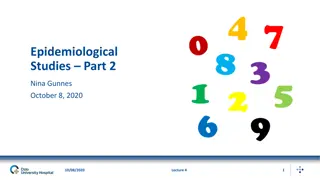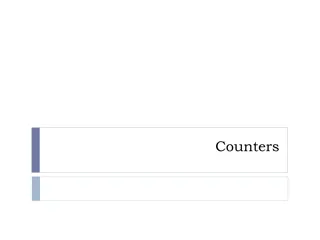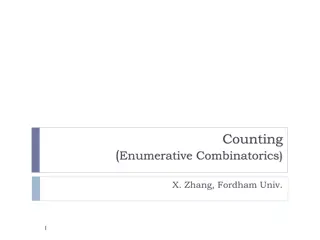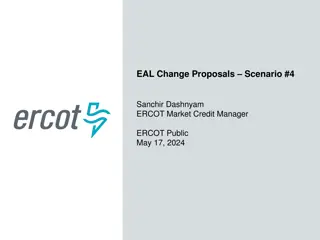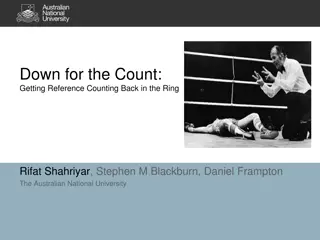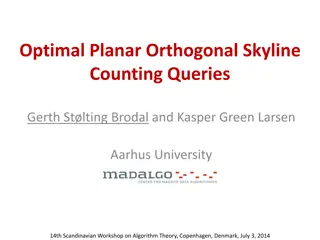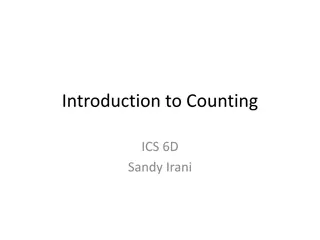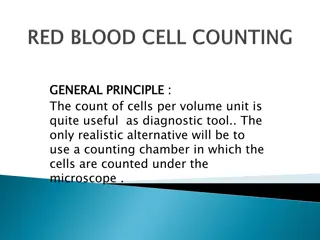Addressing Double Counting and Design Flaws in Energy Market Exposures
Severe over-collateralization and under-collateralization in the energy market expose participants to financial risks. Flaws in the current EAL design, regarding DC Tie Exports, result in mismatches between calculations leading to excessive collateral calls. Correcting these flaws is crucial to protect market stability and prevent unnecessary costs to participants and consumers.
Download Presentation

Please find below an Image/Link to download the presentation.
The content on the website is provided AS IS for your information and personal use only. It may not be sold, licensed, or shared on other websites without obtaining consent from the author.If you encounter any issues during the download, it is possible that the publisher has removed the file from their server.
You are allowed to download the files provided on this website for personal or commercial use, subject to the condition that they are used lawfully. All files are the property of their respective owners.
The content on the website is provided AS IS for your information and personal use only. It may not be sold, licensed, or shared on other websites without obtaining consent from the author.
E N D
Presentation Transcript
Eliminate Double-Counting of DC Tie Exports and EAL Design to Capture Counter-Party Exposure Shams Siddiqi, Ph.D. Representing Rainbow Energy Marketing Company (REMC) (512) 619-3532 shams@crescentpower.net CFSG Meeting June 21, 2023
Introduction Severe over-collateralization not only is a financial burden on QSEs (and now to more QSEs with the elimination of unsecured credit) but is also ultimately paid by consumers Severe under-collateralization exposes the market, and ultimately consumers, with potential cost of default Both are undesirable unfortunately, current flawed design has both aspects some of which can be corrected rather easily without even needing an NPRR because they are related to implementation details not specified in the Protocols Ultimately it is Market Participants, and not ERCOT Inc., that is exposed both to the cost and risks associated with credit requirements and thus MPs need to decide whether to correct these obvious flaws that is unnecessarily costing more, not adequately protecting the market, and unnecessarily resulting in excessive collateral calls and possible termination during scarcity events 2
Flaws with Current EAL Design RTLCNS and RTLF calculations are flawed resulting in double counting of DC Tie Exports - Exports on the Operating Day (OD) and Exports from 7 ODs ago Exports on the OD are correctly accounted for in the DC Tie Net Energy Sales Volume whereas Exports from 7 ODs ago are inadvertently added as part of Total Load (Note: MCE has Exports in Load but no Imports) Total disconnect between RTL and DAL results in huge over- and under-collateralization High DAM charges implies high RTM credits and vice versa for hedged entities but these are not netted Invoice Exposure calculation must also net DAM and RTM invoices for the same OD DALE looks at OD -3 to 9 and extrapolates M1 days whereas RTLE looks at OD -8 to - 40 and extrapolate M1 days If there s scarcity prices in most recent days, DALE can be very high and that is extrapolated M1 days with no corresponding credit for the same RT days not just because RTLE looks at different days but also even the non-extrapolated RTLCNS credits and RTLF credits are not realized because of Max function with RTLE and URTA this results in huge over-collateralization If entity s activities are mostly in RTM in scarcity event, RTLCNS and RTLF should dominate however, RTLCNS only accounts for most recent 5 ODs (whereas exposure is for 7 ODs) and neither RTLCNS nor RTLF are extrapolated for M1 days this may lead of large under-collateralization If RTLE was high for days prior to OD -9 with high DAL credits for those same days, then this sets Max RTLE but not DALE this results in huge over-collateralization RFAF calculated on most recent RTLE days but applied to totally different set of days this results in implied prices that may far exceed SWCAP and huge over-collateralization 3
Proposed EAL design to Capture Exposure Proposed EAL design based on following objective: Must capture exposure based on activity that has already occurred Must cover a conservative estimate of exposure for the next M1 days Exposure based on activity that has already occurred = OUT + Max(0.9*RTLi, 1.1*RTLi) for most recent 7 ODs (weekends and holidays ignored in this presentation for simplicity but actual implementation would take those into account) Extrapolate exposure for M1 days (must take RTM and DAM exposures for the same Operating Day i together since they are interdependent) and take (to be conservative) Max of: Based on most recent activity with forward price adjustment = Average over the most recent 7 ODs [DFAF * DALi + RFAF * RTLi] x M1; DFAF and RFAF are calculated based on exactly the same 7 OD prices Based on maximum historical exposure = Average over 14 settled ODs [DALi + RTLi] x M1 over D previous ODs Thus, EAL formula should be: EAL = OUT + Max(0.9*RTLi, 1.1*RTLi) for most recent 7 ODs + Max(Average over most recent 7 ODs [DFAF * DALi + RFAF * RTLi] x M1, Average over 14 Operating Days [DALi + RTLi] x M1 over D previous days) Essential to get RTLCNS and RTLF right eliminate double counting of DC Tie Exports 4
RTLCNS and RTLF Calculations Current RTLCNS and RTLF use actual OD transacted DC Tie Imports and Exports, QSE- QSE Purchases and Sales, DAM Purchases and Sales, RT Congestion Amount, RT CRR Amount, metered Total Generation but also 7 OD prior DC Tie Exports as part of Total Load This RTLCNS and RTLF calculation detail is not specified in the Protocols and is an obvious error in the implementation of these calculations During scarcity events, RTLCNS and RTLF typically dominate and this flawed double counting of DC Tie Exports can result in unnecessary and severe over-collateralization and possible termination of a QSE that is not Exporting but rather Importing power, is owed large sums by ERCOT, and is helping with system reliability The only change needed to correct this flaw is to modify the Total Load calculation by eliminating DC Tie Exports from that calculation Note: since during scarcity, system Load is typically much higher than usual Load, 7 OD prior DC Tie Export estimate used in RTLCNS and RTLF can greatly exceed the actual Exports from that OD since the estimate is based on Load Ratio Share Note: No other quantity is double counted in RTLCNS and RTLF calculations 5
RTLCNS and RTLF Example 1 QSE with M1=15, M2=9 exports 10,000MWh when prices were $10/MWh for every OD except in last 7 ODs when prices were $1,000/MWh QSE imports 1,000 MWh and say system Load is 20% higher during the scarcity days: Note: OD Net Exposure = -$1M for last 7 ODs; however, assuming all invoices are paid, only 3 days of DAM due and 7 days of RTM owed for net realized exposure of -$7M (extrapolated -$15M) RTLCNS = 1.1*(Total Load * Price + DC Tie Net Energy Sales Volume * Price) = 1.1*(1.2*5*10,000 MWh*$1,000/MWh + 5*(-1,000) MWh*$1,000/MWh) = $60,500,000 RTLF = 1.5*1.1*7*(1.2*10,000-1,000)*1000 = $127,050,000 EAL = $187,550,000 Actual amount QSE owes ERCOT = -1000*1000*7 = -$7,000,000 (i.e., ERCOT owes this amount to the QSE) Eliminating double counting of Exports: RTLCNS = 0.9*5*(-1,000)*1,000 = -$4,500,000 RTLF = 1.5*0.9*7*(-1,000)*1,000 = -$9,500,000 Massive over-collateralization due to double counting of DC Tie Exports 6
RTLCNS and RTLF Example 2 QSE with M1=15, M2=9 exports 10,000MWh when prices were $10/MWh for every OD except in last 7 ODs when prices were $1,000/MWh QSE exports 1,000 MWh and say system Load is 20% higher during the scarcity days: Note: OD Net Exposure = $1M for last 7 ODs; however, assuming all invoices are paid, only 3 days of DAM due and 7 days of RTM owed for net realized exposure of $7M (extrapolated $15M) RTLCNS = 1.1*(Total Load * Price + DC Tie Net Energy Sales Volume * Price) = 1.1*(1.2*5*10,000 MWh*$1,000/MWh + 5*1,000 MWh*$1,000/MWh) = $71,500,000 RTLF = 1.5*1.1*7*(1.2*10,000+1,000)*1000 = $150,150,000 EAL = $221,650,000 Actual amount QSE owes ERCOT = 1000*1000*7 = $7,000,000 Eliminating double counting of Exports: RTLCNS = 1.1*5*1,000*1,000 = $5,500,000 RTLF = 1.5*1.1*7*1,000*1,000 = $11,550,000 Massive over-collateralization due to double counting of DC Tie Exports Note: Ideally, for Loads that have telemetry or other means for ERCOT to determine OD consumption, e.g. LFLs, those values should be used. For other Loads, ERCOT should apply escalation factors to their values from OD -7. 7
EAL Example 1 QSE with M1=15, M2=9 buys $1M in DAM and sells $1M in RTM for every OD except in last 7 ODs due to 10 times higher prices QSE buys $10M in DAM and sells $10M in RTM with forward market reflecting recent prices: Note: OD Net Exposure = $0 for all ODs including last 7 ODs; however, assuming all invoices are paid, only 3 days of DAM due and 7 days of RTM owed for net exposure of -$40M Current EAL (huge over-collateralization or positive gap): RFAF = 10, Max RTLE = -$150M, RTLCNS = -$45M, RTLF = -$94.5M, Max URTA = -$20.6M DFAF = 1.6, DALE = $150M, OUT = $30M EAL = Max(Max RTLE, RTLF) + Max(RTLCNS, Max URTA) + DALE + OUT = -94.5-20.6+150+30 = $64.9M Proposed EAL: RFAF = 1, DFAF = 1 (based on highest price day in last 7 days) Most recent 7 ODs = [DFAF*DALi + RFAF*RTLi] x M1 = [$10M - $10M] x 15 = $0 Historical D previous ODs = [DALi + RTLi] x M1 = $0 EAL = Max(Most recent 7 ODs, Historical D previous ODs)+OUT+ Max(0.9*RTLi, 1.1*RTLi) for most recent 7 ODs = 0+30-63 = -$33M Reasons Current EAL is so disconnected from actual exposure: DALE and Max RTLE are using totally disconnected ODs and not looking at Net (DAM+RTM) exposure; RTLF discounted credit is only for 10.5 days instead of M1 days DALE and Max URTA are also using totally disconnected ODs and Max URTA is not allowing RTLCNS credit 8
EAL Example 2 QSE with M1=15, M2=9 sells $1M in DAM and buys $1M in RTM for every OD except in last 7 ODs due to 10 times higher prices QSE sells $10M in DAM and buys $10M in RTM with forward market reflecting recent prices : Note: OD Net Exposure = $0 for all ODs including last 7 ODs; however, assuming all invoices are paid, only 3 days of DAM owed and 7 days of RTM due for net exposure of $40M Current EAL (under-collateralization or negative gap): RFAF=10, Max RTLE = $150M, RTLCNS = $55M, RTLF = $115.5M, Max URTA = $20.6M DFAF=1.6, DALE = -$150M, OUT = -$30M EAL = Max(Max RTLE, RTLF) + Max(RTLCNS, Max URTA) + DALE + OUT = 150+55-150-30 = $25M Proposed EAL: RFAF = 1, DFAF = 1 Most recent 7 ODs = [DFAF*DALi + RFAF*RTLi] x M1 = [$10M - $10M] x 15 = $0 Historical D previous ODs = [DALi + RTLi] x M1 = $0 EAL = Max(Most recent 7 ODs, Historical D previous ODs)+OUT+7-RTLCNS = 0-30+77 = $47M Reasons Current EAL is disconnected from actual exposure: DALE and Max RTLE are using totally disconnected ODs and not looking at Net (DAM+RTM) exposure; however, RTLF is making up for some of this gap DALE and Max URTA are also using totally disconnected ODs; however, RTLCNS is making up for some gap 9
EAL Example 3 QSE with M1=15, M2=9 sells $1M in DAM and buys $1M in RTM for every OD and market prices and forward prices were all $1,000/MWh except Day 21 to Day -8 prices were $10/MWh: Note: OD Net Exposure = $0 for all ODs including last 7 ODs; however, assuming all invoices are paid, only 3 days of DAM owed and 7 days of RTM due for net exposure of $4M Current EAL (huge over-collateralization or positive gap): RFAF=100, Max RTLE = $1,500M, RTLCNS = $5.5M, RTLF = $11.55M, Max URTA = $9M DFAF=1, DALE = -$15M, OUT = -$3M EAL = Max(Max RTLE, RTLF) + Max(RTLCNS, Max URTA) + DALE + OUT = 1500+9-15-3 = $1,491M Proposed EAL: RFAF = 1, DFAF = 1 Most recent 7 ODs = [DFAF*DALi + RFAF*RTLi] x M1 = [$10M - $10M] x 15 = $0 Historical D previous ODs = [DALi + RTLi] x M1 = $0 EAL = Max(Most recent 7 ODs, Historical D previous ODs)+OUT+ Max(0.9*RTLi, 1.1*RTLi) for most recent 7 ODs = 0-3+7.7 = $4.7M Reasons Current EAL is disconnected from actual exposure: RFAF is based on most recent RTLE but is applied to prior days when prices were 100 times as high implied price for those ODs in Max RTLE is $100,000/MWh resulting in massive over-collateralization 10
EAL Example 4 QSE with M1=15, M2=9 buys $2M in DAM and sells $1M in RTM for every OD except in last 7 ODs due to 10 times higher prices QSE buys $20M in DAM and sells $10M in RTM with forward market reflecting recent prices : Exposure = 3 days of DAM, 7 days of RTM, 15 days of net invoice = 60-70+10*15 = $140M Current EAL (huge over-collateralization or positive gap): RFAF = 10, Max RTLE = -$150M, RTLCNS = -$45M, RTLF = -$94.5M, Max URTA = -$20.6M DFAF = 1.6, DALE = $300M, OUT = $60M EAL = Max(Max RTLE, RTLF) + Max(RTLCNS, Max URTA) + DALE + OUT = -94.5-20.6+300+60 = $244.9M Proposed EAL: RFAF = 1, DFAF = 1 (based on highest price day in last 7 days) Most recent 7 ODs = [DFAF*DALi + RFAF*RTLi] x M1 = [$20M - $10M] x 15 = $150 Historical D previous ODs = [DALi + RTLi] x M1 = $15 EAL = Max(Most recent 7 ODs, Historical D previous ODs)+OUT+ Max(0.9*RTLi, 1.1*RTLi) for most recent 7 ODs = 150+60-63 = $147M 11
EAL Example 5 QSE with M1=15, M2=9 sells $1M in DAM and buys $2M in RTM for every OD except in last 7 ODs due to 10 times higher prices QSE sells $10M in DAM and buys $20M in RTM with forward market reflecting recent prices : Exposure = 3 days of DAM, 7 days of RTM, 15 days of net invoice = -30+140+10*15 = $260M Current EAL (under-collateralization or negative gap): RFAF=10, Max RTLE = $300M, RTLCNS = $110M, RTLF = $231M, Max URTA = $41.1M DFAF=1.6, DALE = -$150M, OUT = -$30M EAL = Max(Max RTLE, RTLF) + Max(RTLCNS, Max URTA) + DALE + OUT = 300+110-150-30 = $230M Proposed EAL: RFAF = 1, DFAF = 1 Most recent 7 ODs = [DFAF*DALi + RFAF*RTLi] x M1 = [-$10M + $20M] x 15 = $150 Historical D previous ODs = [DALi + RTLi] x M1 = $15 EAL = Max(Most recent 7 ODs, Historical D previous ODs)+OUT+ Max(0.9*RTLi, 1.1*RTLi) for most recent 7 ODs = 150-30+154 = $274M 12
EAL Example 6 QSE with M1=15, M2=9 has no (or negligible) activity for every OD except in last 7 ODs QSE buys $1M in RTM with forward market reflecting recent prices : Exposure = 3 days of DAM, 7 days of RTM, 15 days of net invoice = 0+7+1*15 = $22M Current EAL (under-collateralization or negative gap): Max RTLE = $0, RTLCNS = $5.5M, RTLF = $11.55M, Max URTA = $1.3M EAL = Max(Max RTLE, RTLF) + Max(RTLCNS, Max URTA) + DALE + OUT = 5.5+11.55+0+0 = $17.05M Proposed EAL: Most recent 7 ODs = [DFAF*DALi + RFAF*RTLi] x M1 = [$0 + $1M] x 15 = $15 Historical D previous ODs = [DALi + RTLi] x M1 = $0 EAL = Max(Most recent 7 ODs, Historical D previous ODs)+OUT+ Max(0.9*RTLi, 1.1*RTLi) for most recent 7 ODs = 15+0+7.7 = $22.7M 13
Uri Example 7 QSE with M1=10, M2=9 buys all DC_N Tie flow in DAM and sells all DC_N Tie flow in RTM for every OD in January and February 2021: Current EAL Huge Over-Collateralization and Proposed EAL Conservatively Over- Collateralized and follows Actual M1-Day Invoice Exposure (Note: DFAF & RFAF under Proposed EAL based on current DFAF) 14





